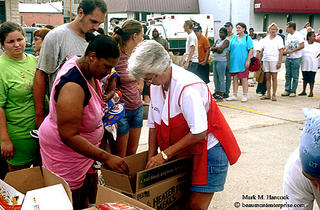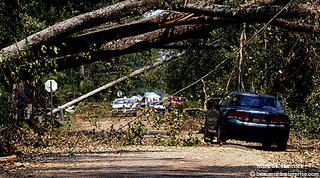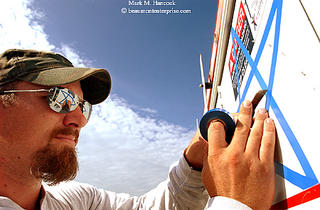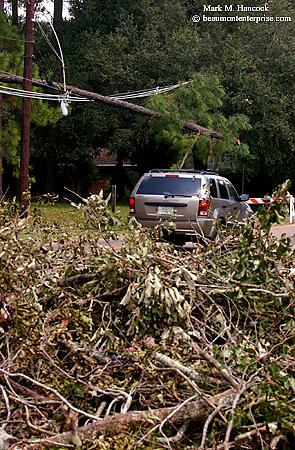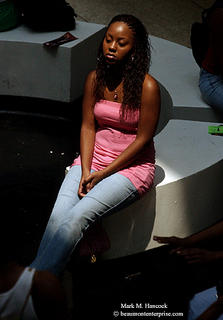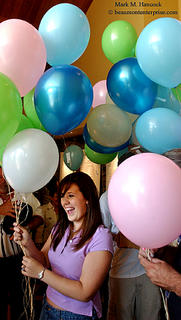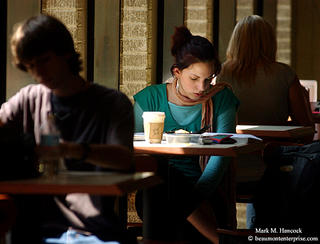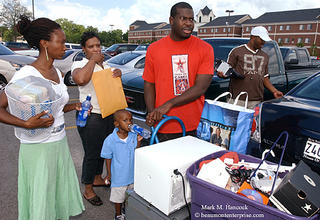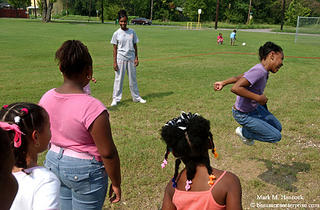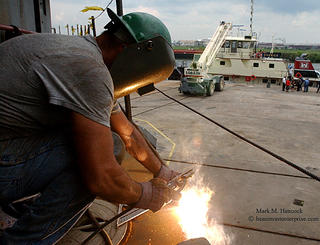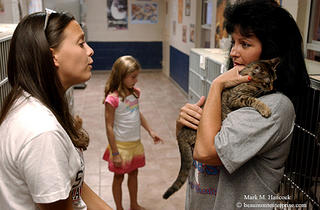We've discussed the
portfolio and
where to look for staff jobs, how to
research newspaper circulations and even how to
create a job hunt database to track applications. Now we need a resume.
Our resume is for a specific desired position (typically posted on a job information bank). While the local newspaper might be happy with a few e-mailed images or an online portfolio and resume, our resume is designed to snag a decent job with a living wage.
Here's what I think works because it works for me. Other PJs should do what works best for them. If the editors at major metros offer a gig to PJs with recycled newspaper and duct tape resumes, good for those PJs.
Targeted submissionsIn the old days, job hunters would type, correct, type, correct and finally perfect a generic resume on paper. Then, they'd go to a printer and have 100 copies of the same exact resume printed. They'd stuff 100 envelopes, drop them in the mail and wait for responses.
Those days are gone.
Computers introduced additional areas of job competition (and weeding points for editors). Now, resume packages must be superior and customized to specific editors and publications.
The cover letter, resume and portfolio CD must be specifically designed for the publication and the person who picks the next employee. All forms of communication need to include the hiring person's name or the publication's name. Like the portfolio, it must also convey a coherent message of professionalism (and possibly quirkiness).
If not, it's two seconds away from a form "Thanks, but no thanks" response (if any).
StationarySome believe paper quality is a measure of the sender's worth. Consequently, use a high-percentage cotton paper and matching envelopes. This paper is sold at most office supply stores in fancy boxes of 25 sheets. The matching envelopes should be somewhere nearby. If possible, it should match the PJ's
business cards.
High-quality stationary is expensive if the job hunt is long, but it should pay for itself in the long run.
Even if an editor isn't impressed with the paper quality, high-quality stationary won't be the reason a PJ didn't get past the first round. However, cheap paper could.
ColorStationary color is important. When applying to a professional job, use professional colors. The most common colors for PJs are cream, light blue and light gray (flat, granite or marble) with some minor texture (linen).
Although neon colors (orange in particular) grab attention, it may not be the optimal choice for a resume. If the color of the stationary makes it difficult to read the print on the page, consider another color.
FontThere is a serif vs. sans serif debate. Studies say body text with serifs and headlines with sans serif fonts are easiest to read. Personally, I go with Times New Roman (serif) across the board because it's a professional font - boring, but professional.
Unless you're really confident with your name recognition and design abilities, avoid multiple fonts. The "ransom note" approach is often interpreted as youthful over exuberance. Since many editors prefer seasoned PJs, the ransom note might not get far.
If a PJ doesn't buy my rationale, at least keep font patterns consistent throughout the whole package. Don't change to traditional after the cover letter.
While we're at it, keep text aligned left and at a reasonable font size (12 point) and avoid all capital letters (read as a scream). Finally, eschew
exclamation points.
Resume formatThe latest trend is to list everything an employer could ever want to know about a possible new PJ. Supporters think it's important to list each program of competence, each nuanced specialty, etc.
Honestly, editors are too darn busy and want to know who the PJ is, what they've done, if they need additional training and if they can provide a needed specialty (languages, access, lighting style, etc.).
New PJs may need to note their skills and experience (media law particularly). This lets employers know the PJ can be an asset rather than a liability.
An additional drawback of the novella resume is weeding points. Employee searches are like
photo contests. All PJs start out equal. Most choose to eliminate themselves. When faced with boxes of resumes in addition to the normal daily workload, it's understandable for editors to eliminate as many as they can before reading the entire content of each package.
Weak resumes will be eliminated early. The remaining resumes and portfolios are reviewed. The reasons resume packages are rejected are as numerous as the editors who must slog through the portfolios.
For premium jobs, immediate rejections occur if a PJ has no degree, has no background, has a non-news portfolio (different genre), or is incredibly sloppy. Secondary elimination points are lack of professional awards and lack of pro affiliations (
NPPA,
SPJ and
SND are favored).
Next, PJs must navigate the personal preferences of the editor (again varied by editor) as well as unexpected problems on the editor's desk (bad moods, portfolio review interruptions, resume left on conference table, resume placed with rejects instead of keepers, coffee spilled on CD or resume, etc.).
Aside from the out-of-control issues, full-scale resumes can give editors other chances to reject resumes. If editors don't want to read entire resumes to get facts, they won't. Additionally, if the barrage of information doesn't have the exact program version the newspaper uses, it's yet another reason to reject an applicant.
I only list my contact info, objective, education, job titles/employers, awards, affiliations and references on my hard copy
resume (online version is different). It may be too simple, but anyone who wants to hire me understands I know all the appropriate computer programs, media law and other essential job qualifications. Otherwise, I wouldn't have the previous jobs or awards.
Sections of a brief resumeIf needing a resume from scratch, here's a way to construct it. If others have already had success with their resumes, go with what works.
Like news stories, the first page is the only page read unless the editor is compelled to continue reading. It's the job applicant's mission to inform the editor of unique qualifications and pull the editor through the application process.
Consequently, a tight resume lets editors know the PJ appreciates and values the editors' time. One page is good. A two-page resume works for experienced PJs with many awards. The third page is unlikely to get a serious look on the first round.
Contact blockThe contact information should be the first part of all correspondence. If PJs get into the keeper pile of resumes, making an editor search for a phone number could move the resume to the reject pile.
The contact block should include the PJ's name, home and mobile numbers, home address, e-mail address (preferably a private e-mail rather than a corporate [subject to review by supervisor] address), Web sites and other contact information.
I also include my blogs here. I'd rather a potential employer know about my blogs and review them before they hire me. I don't want to be
dooced down the road. It's also a good idea to have separation of blog and work in writing before accepting a job. Otherwise, the new employer might feel they have the right to interfere with, influence or lay claim to blog content.
ObjectiveThis is a very specific explanation (one or two sentences) of an applicant's desired job. When applying for a specific job at a specific publication, it should match the job posting on both counts.
Example:
Professional photojournalist seeks a full-time staff photojournalist position at XYZ Newspaper. If the job posting is for a staff photographer, apply for the "photographer" position.
By adding the publication's name, it customizes the resume for the client and let's the editor know the PJ wants this particular job. It's not an application to "anywhere in the Northern Hemisphere."
The next sections can be in any order, however this order might work best.
EducationThis is a major weeding issue, so let's get it resolved rapidly. List any degree(s) obtained, the full university name and the year(s) each was obtained.
If a PJ's GPA was particularly good, include it. Otherwise, it's assumed everyone has a 3.5 (of 4) or better GPA. If not, be ready to explain low grades during the pre-screening call - explanations better be good and true.
ExperienceThis is another weeding point. If the job requires 10 years experience at a daily metro newspaper, two years at a 5K weekly won't work.
Likewise, three years of daily photo experience at a portrait studio is not the same as three years at a daily paper.
The last 10 years are fine for this section. Add military and years of service to get some bonus points with some editors (or lose points with others).
SkillsNew PJs may want to substitute skills for experience. List skills as bullet statements to show competencies expected for the job description. These are typically listed on job postings. Don't list skills unless the PJ has a proven competence. Good editors eventually ask to see proof.
More experienced PJs might list current job duties. Again, the top-listed duties should apply directly to the position sought and job description. Although old timers appreciate the ability to develop and print film in a hotel bathroom, it doesn't apply to modern PJ jobs.
AwardsThe listed awards should be PJ, design or journalism related. It's interesting if a PJ won a ballroom dancing competition, but it doesn't apply to the job.
Depending on the PJ's experience and competitive inclination, there are several ways to list awards. Below are the three most common.
1) Reverse chronologically: Place the newest awards at the top as they are acquired.
2) Award level: Awards are grouped by ordinal number (1st, 2nd, 3rd, finalist, honorable mention).
3) Prestige level: Awards are listed by competitive factor (Pulitzer, WPP, POYi, state awards, collegiate, parks and recreation department, etc...).
AffiliationsThis is a minor weeding point. If the publication pays dues, most folks join. If it doesn't, some might not join. However, it's a rapid way for an editor to assess the ethical and professional background of a candidate.
College students and those considering the profession should be members of both NPPA and SPJ. Membership includes subscriptions to
News Photographer magazine (NPPA) and
Quill magazine (SPJ). They are both good cover-to-cover reads for beginning PJs and pros alike. Both offer substantial student membership discounts. It's reasonably affordable to be a member of both while in college.
ReferencesIf anything is hotly debated, it's references. As a general rule, it's best to include name, phone number and e-mail addresses for references in a hard copy resume. This information rounds out the second page of a tight resume. It also provides an editor with the immediate information to fill the job.
For online resumes, state references provided upon request and link the words "upon request" to the PJ's e-mail address. It's unlikely to solicit requests, but it keeps the PJ's references on the PJ's good side (a critical issue).
Enough for now,


